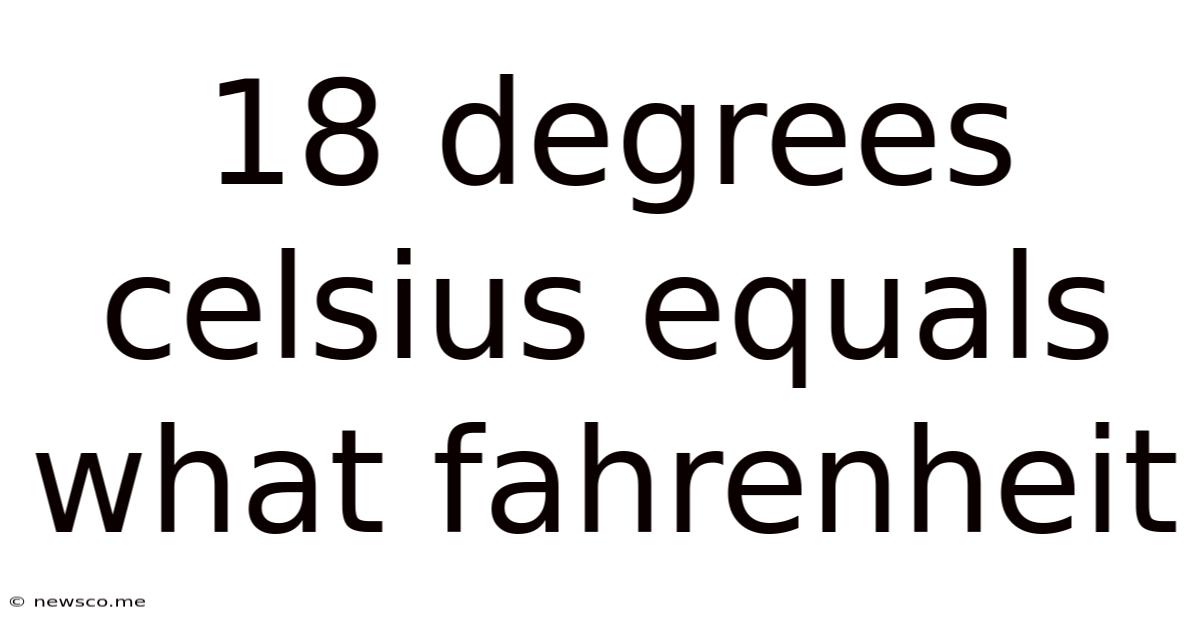18 Degrees Celsius Equals What Fahrenheit
News Co
Apr 03, 2025 · 5 min read

Table of Contents
18 Degrees Celsius Equals What Fahrenheit? A Comprehensive Guide to Temperature Conversions
Understanding temperature conversions is crucial in many aspects of life, from cooking and baking to understanding weather reports and scientific experiments. While Celsius (°C) is the most widely used temperature scale globally, Fahrenheit (°F) remains prevalent in certain regions, particularly the United States. This comprehensive guide will not only answer the question "18 degrees Celsius equals what Fahrenheit?" but also delve into the underlying principles of temperature conversion, offering practical tips and examples to master this essential skill.
Understanding the Celsius and Fahrenheit Scales
Before diving into the conversion, let's briefly explore the origins and characteristics of both scales:
Celsius (°C)
- Origin: Developed by Anders Celsius in the 18th century, the Celsius scale is a metric system temperature scale.
- Freezing Point of Water: 0°C
- Boiling Point of Water: 100°C
- Key Feature: Uses a 100-degree interval between the freezing and boiling points of water, making it a decimal-based system.
Fahrenheit (°F)
- Origin: Developed by Daniel Gabriel Fahrenheit in the early 18th century, the Fahrenheit scale is an imperial system temperature scale.
- Freezing Point of Water: 32°F
- Boiling Point of Water: 212°F
- Key Feature: Uses a larger interval (180 degrees) between the freezing and boiling points of water.
Calculating 18°C in Fahrenheit
The conversion between Celsius and Fahrenheit is achieved through a simple formula:
°F = (°C × 9/5) + 32
Applying this formula to 18°C:
°F = (18 × 9/5) + 32
°F = (162/5) + 32
°F = 32.4 + 32
°F = 64.4
Therefore, 18 degrees Celsius is equal to 64.4 degrees Fahrenheit.
Beyond the Formula: Understanding the Conversion Process
The formula itself is straightforward, but understanding the underlying logic enhances comprehension. The conversion involves two key steps:
-
Scaling: The ratio 9/5 reflects the difference in the size of the degrees between the two scales. Fahrenheit degrees are smaller than Celsius degrees. Multiplying the Celsius temperature by 9/5 adjusts for this difference in scale.
-
Offset: The addition of 32 accounts for the difference in the zero points of the two scales. The freezing point of water is 0°C but 32°F. This offset ensures accurate conversion.
Practical Applications of Temperature Conversions
The ability to convert between Celsius and Fahrenheit is essential in various fields:
Cooking and Baking:
Recipes often specify temperatures in either Celsius or Fahrenheit. Accurate conversion ensures the desired results in your culinary creations. For example, a recipe calling for 175°C would require conversion to Fahrenheit for those using Fahrenheit-based ovens.
Meteorology and Weather Forecasting:
Understanding both scales is vital for interpreting weather reports, especially when comparing international forecasts. A weather report showing 18°C in one country might require conversion to Fahrenheit for accurate comparison to a Fahrenheit-based report in another.
Science and Engineering:
Many scientific experiments and engineering applications require precise temperature control. The ability to convert between scales ensures accurate data collection and interpretation across different measurement systems.
Healthcare:
Body temperature measurements are often recorded in both Celsius and Fahrenheit. Accurate conversion is essential for diagnosis and treatment.
International Travel:
Understanding both temperature scales is particularly helpful when traveling internationally, ensuring easy interpretation of weather information and adjusting clothing accordingly.
Inverse Conversion: Fahrenheit to Celsius
The reverse conversion, from Fahrenheit to Celsius, uses the following formula:
°C = (°F - 32) × 5/9
This formula effectively reverses the scaling and offsetting steps used in the Celsius to Fahrenheit conversion.
Tips for Accurate Temperature Conversions
- Use a Calculator: While the formula is simple, using a calculator ensures accuracy, particularly with decimal values.
- Double-Check Your Work: Always verify your calculations to minimize errors.
- Online Converters: Numerous online temperature converters are readily available, providing a quick and easy way to verify your calculations.
- Understand the Logic: Focusing on the underlying scaling and offsetting principles aids in comprehension and error prevention.
Frequently Asked Questions (FAQs)
Q: Why are there two different temperature scales?
A: The two scales arose independently, reflecting different historical and scientific contexts. Celsius is based on a decimal system, aligning with the metric system, while Fahrenheit has a longer history and continues to be used in specific regions.
Q: Is it possible to make mistakes in the conversion?
A: Yes, simple calculation errors are possible. Careful attention to the formula and using a calculator minimizes errors.
Q: Are there other temperature scales besides Celsius and Fahrenheit?
A: Yes, Kelvin is another widely used scale in science and engineering, representing absolute temperature.
Q: What is the significance of the 9/5 ratio in the conversion formula?
A: The ratio reflects the difference in the size of degrees between Celsius and Fahrenheit. Fahrenheit has smaller degrees, requiring this ratio for accurate scaling.
Q: What's the best way to learn temperature conversions?
A: Practice is key! Start by converting a few temperatures using the formula, then test yourself with different examples. Understanding the underlying principles will solidify your knowledge.
Conclusion
Converting between Celsius and Fahrenheit is a fundamental skill with numerous practical applications. While the formula may seem simple, understanding its underlying principles ensures accurate conversions and broadens comprehension of temperature measurement systems. Whether you're baking a cake, interpreting a weather report, or performing a scientific experiment, mastering temperature conversions enhances your efficiency and accuracy. By following the methods outlined in this guide, you can confidently navigate the world of temperature conversions and apply this knowledge to various real-world scenarios. Remember to practice regularly and utilize available resources to solidify your understanding and achieve accurate results.
Latest Posts
Related Post
Thank you for visiting our website which covers about 18 Degrees Celsius Equals What Fahrenheit . We hope the information provided has been useful to you. Feel free to contact us if you have any questions or need further assistance. See you next time and don't miss to bookmark.